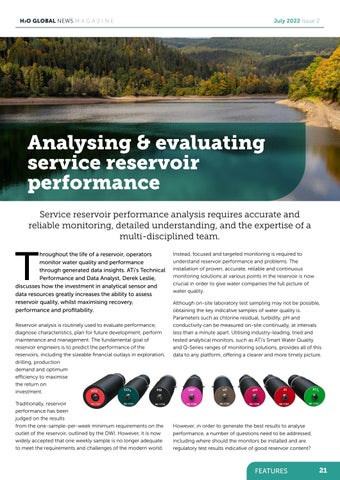H2O GLOBAL NEWS M A G A Z I N E
July 2022 Issue 2
Analysing & evaluating service reservoir performance Service reservoir performance analysis requires accurate and reliable monitoring, detailed understanding, and the expertise of a multi-disciplined team.
T
hroughout the life of a reservoir, operators monitor water quality and performance through generated data insights. ATi’s Technical Performance and Data Analyst, Derek Leslie, discusses how the investment in analytical sensor and data resources greatly increases the ability to assess reservoir quality, whilst maximising recovery, performance and profitability.
Reservoir analysis is routinely used to evaluate performance, diagnose characteristics, plan for future development, perform maintenance and management. The fundamental goal of reservoir engineers is to predict the performance of the reservoirs, including the sizeable financial outlays in exploration, drilling, production demand and optimum efficiency to maximise the return on investment. Traditionally, reservoir performance has been judged on the results from the one-sample-per-week minimum requirements on the outlet of the reservoir, outlined by the DWI. However, it is now widely accepted that one weekly sample is no longer adequate to meet the requirements and challenges of the modern world.
Instead, focused and targeted monitoring is required to understand reservoir performance and problems. The installation of proven, accurate, reliable and continuous monitoring solutions at various points in the reservoir is now crucial in order to give water companies the full picture of water quality. Although on-site laboratory test sampling may not be possible, obtaining the key indicative samples of water quality is. Parameters such as chlorine residual, turbidity, pH and conductivity can be measured on-site continually, at intervals less than a minute apart. Utilising industry-leading, tried and tested analytical monitors, such as ATi’s Smart Water Quality and Q-Series ranges of monitoring solutions, provides all of this data to any platform, offering a clearer and more timely picture.
However, in order to generate the best results to analyse performance, a number of questions need to be addressed, including where should the monitors be installed and are regulatory test results indicative of good reservoir content?
FEATURES
21
